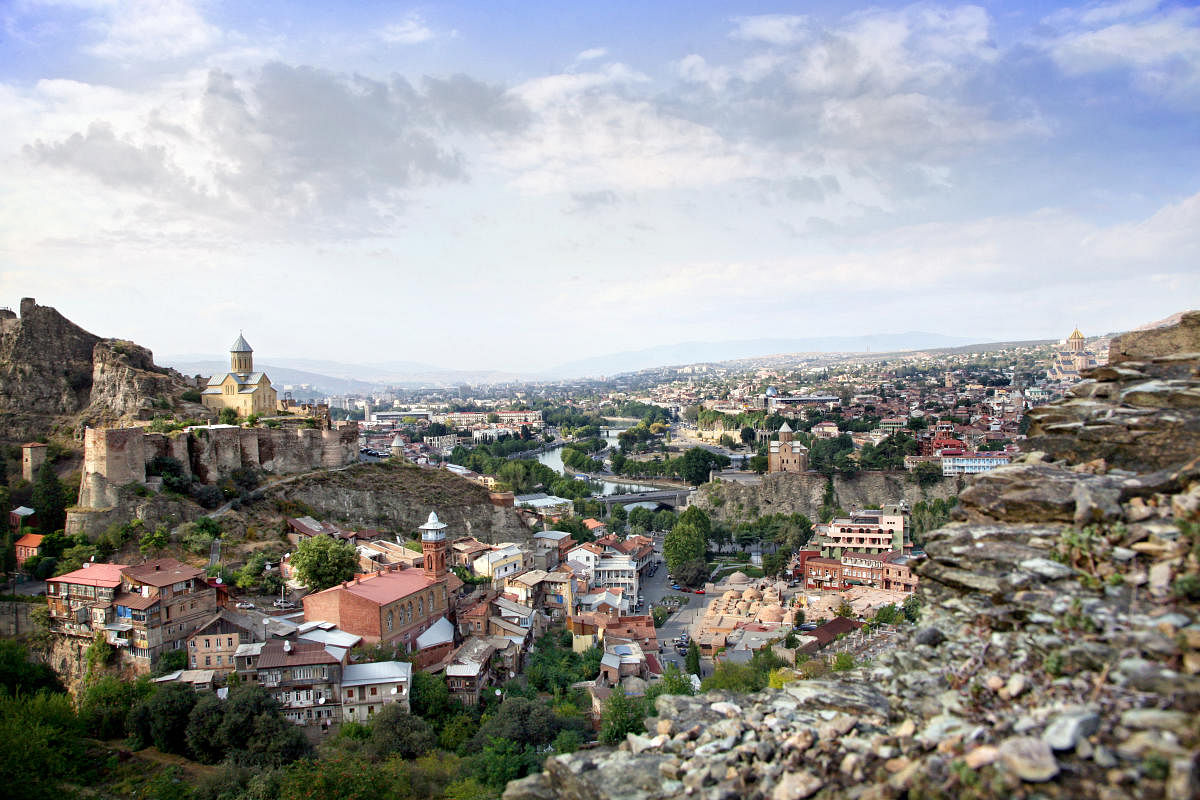
Standing at the crossroads of Europe and Asia, Georgia’s capital city of Tbilisi straddles both the worlds with equal ease — from its cobbled streets dotted with Orthodox Christian churches to its trendy bars and restaurants. There’s something for everyone, whether it’s an iconic 12th-century church or a decadent 18th-century bathhouse powered by natural hot sulphur springs or a lively flea market brimming with Soviet-era memorabilia. Don’t miss the local cuisine, which is a mix of Mediterranean and Central Asian influence. And of course, there’s some rather excellent wine to go with it — little-known fact, Georgia is the birthplace of wine! Here’s how to make the most of Tbilisi.
Church story
Christianity arrived in Georgia in the 4th century through Saint Nino, a Greek-speaking woman from Cappadocia who was said to be related to Saint George. Today, more than 80% of Georgians practise Orthodox Christianity and most follow the Georgian Orthodox Church. As the capital, Tbilisi has several stunning Orthodox Churches. Of these, the Holy Trinity Cathedral of Tbilisi (commonly known as Sameba) is the main church of the city and the largest Orthodox Church in Georgia. Built in 2004, the church towers over the city from the Elia Hill on the left bank of the Kura River (also known as Mtkvari). It’s built in the traditional Georgian style but is much taller than usual and is topped off with a monumental dome and a 7.4 metre-tall gilded cross.
Also standing on the left bank of the river atop a rocky outcrop is the other iconic church of the city, the Metekhi Virgin Mary Assumption Church. King Vakhtang Gorgasali, who founded the city, built the first church on this location in the 6th century. The current building dates to the 12th century. It’s much simpler and less adorned than the cathedral but has a stark beauty to it. A massive equestrian statue of King Gorgasali (built in the 1960s) stands proudly next to it. Another church worth visiting is the Sioni Cathedral in downtown Tbilisi.
The current building dates to the 13th century with modifications made in the 17th -19th centuries. The cathedral is significant as it is home to the original cross of St Nino made from vine branches bound by the saint’s own hair.
Slice of history
Located in central Tbilisi on the arterial Rustaveli Avenue is the Georgian National Museum comprising three separate museums — Museum of Georgia, Museum of Fine Arts, and the National Gallery. The Museum of Georgia houses a superb archaeological collection with artefacts dating back to 3000 BC. The highlight is a stunning jewellery collection of pre-Christian era gold, silver, and gemstones found in ancient burial sites. The Museum of Fine Arts takes you through Georgia’s medieval history through its arts and culture, while the National Gallery houses a huge collection of Georgian paintings and sculpture. Particularly noteworthy are the artworks of Niko Pirosmani, a 19th-century Georgian painter who rose to international fame posthumously.
Soak it in
In the Abanotubani neighbourhood of Old Town Tbilisi stand a cluster of historic 18th-century bathhouses. The domed brick bathhouses stand atop mineral sulphur springs that give Tbilisi its name, which literally translates to ‘warm place’. Bathing in the hot springs was a popular activity not just with locals but also merchants and caravans passing through the city on the Old Silk Road. Today, less than ten bathhouses still survive. Most of them are public baths though some offer private rooms too. Public baths are divided by gender and many locals prefer to bathe in the nude, though you’re welcome to wear a swimsuit. The sulphuric water is warm and relaxing at about 40-50°C, and also supposedly therapeutic for skin ailments.
Tasting portions
Georgia is a boon for the foodie traveller. And for vegetarians! The traditional Georgian supra or feast is an elaborate affair and the table is literally heaving with multiple courses of food and excellent wine. You would typically begin with pkhali, a sort of pâté made with minced vegetables mixed with a walnut-based sauce. Vegetables such as spinach, beetroot, aubergine, carrots, etc., are most typical and the pkhali comes with a side of bread. Another Georgian staple is khachapuri, a flatbread stuffed with salty mozzarella-like local cheese called Sulguni. Then there’s lobiani, which is similar to khachapuri but with a stuffing of boiled and mashed black kidney beans. The beans also make an appearance in lobio, a thick stew served with pickled vegetables and cornbread called mchadi. Also try ajapsandali, a ratatouille of sorts with aubergine and bell peppers, flavoured with the spicy, garlicky sauce, adjika. For meat lovers, there’s assorted mtsvadi, essentially skewered meats cooked over an open flame, and khinkali or soup dumplings.
Wine country
Think of wine and automatically countries such as France, Italy, and Spain come to mind, followed by Australia, South Africa, etc. But the actual birthplace of wine is Georgia, where archaeologists have traced the world’s first known wine creation to 6000 BC. Early Georgians discovered that they could turn grape juice into wine by burying it underground in terracotta pots. This traditional method of wine making is still practised in Georgia.
Travel the wine route in Kakheti, Georgia’s premier wine-growing region, and stop at any of the wineries to learn how Georgian winemaking differs from the European method. Grape juice is fermented along with skin, seeds, and stalks, which gives the wines a darker colour (even the whites have a golden glow). The fermentation takes place in a qvevri, a pointed terracotta pot that is buried in the floor of the wine cellar.
The sediment sinks to the bottom and the resultant wine is close to natural, without any additional sulphates. The qvevris vary in size and can be as tall as a grown man or even as high as two storeys!